【大会講演紹介】知られざる旧北区の蝶類3種について [世界の蝶 / Butterflies World]

▲シロウラジャノメ(Lopinga eckweileri)の棲息地(Jiuzhaigou, Sichuan, China)
【大会講演紹介】知られざる旧北区の蝶類3種について(G. C. Bozano)

▲シロウラジャノメ(Lopinga eckweileri)
2010年度に当会の林賞を受賞したイタリア・ミラノの研究家G. C. Bozano氏は旧北区の蝶類について該博な知識をお持ちであるばかりか、70歳になる今も精力的に調査行を続けておられる。今回はごく最近、新たに資料が得られた稀種3種について発表していただく。そのうちの1種を紹介しよう。
シロウラジャノメ(Lopinga eckweileri)は中国特産種で、ドイツ人によって中国四川省北部の九寨溝(Jiuzhaigou)から発見された美しいウラジャノメの一種である。ウラジャノメは茶色という常識を覆し、上品な白地に眼状紋を欠く装いは高貴さを感じさせる。タイプシリーズは9♂1♀で記載されているようであるが、その後の情報に乏しい。
G. C. Bozano氏は長らくこの中国特産の稀種を追い求めてきたが、今年タイプ産地を訪れ、実際に生態を観察することができたという。他の近縁種のウラジャノメと違って、発生期が早く、ブッシュや樹上を敏速に飛ぶという。
さて、残り2種は…!? それは当日のお楽しみに!!

にほんブログ村
【大会講演紹介】ミャンマー西部で発見された新属新種のゼフィルス [世界の蝶 / Butterflies World]

▲新属新種が発見されたミャンマー・チン州の照葉樹林
【大会講演紹介】ミャンマー西部で発見された新属新種のゼフィルス(静谷英夫・小岩屋敏)
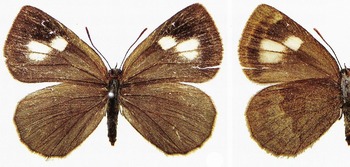
▲コーティアンミドリシジミ・パラタイプの♀(Burmaozephyrus kothayaungi )
もうあと1週間しかないので、いきなり今回の大会講演の目玉を紹介してしまおう。
新種の発見は運が無いとできないが、そこに至る努力と経験が欠かせないのもまた事実である。今回、ミャンマー西部・チン州の山岳地帯で発見された新属新種のコーティアンミドリシジミ(Burmaozephyrus kothayaungi )は、静谷英夫氏のミャンマーでの20年にわたる真摯な探索の末にもたらされた、偉大な成果である。
静谷氏は今年6月、単独でチン州の山岳地帯に分け入り、1♂10♀の不思議なシジミチョウを得た。すでに発生期の後半であり、もし1週間遅かったら、発見できなかった可能性も高い。発見された場所は古くからの街道の脇であり、過去にイギリス人の採集家も何人も通った場所である。こんな衝撃の新種がまだ眠っているのだから、ミャンマーも本当に奥が深い。野瀬幸信氏の組織した調査隊と併せ、ミャンマーでここ10年余りの間に発見されたゼフィルスの新種は12種にものぼっている。まだまだアッと驚くような種が密かに棲息していることが期待される。
今回は発見した静谷英夫氏本人に発見時のエピソードを、発見直後に撮影された映像を交えて紹介していただくことになっている。じつはその後のストーリーもあるのだが、それは当日のお楽しみとしておこう。
(追記) なんと! 発表者、静谷氏から驚きのビッグプレゼント!
ミャンマーの秘蔵ゼフィルスコレクションを特別公開っっ!!

▲ゼフィルスファン垂涎のミャンマーのゼフィルスコレクション(ほんの一部です)
何と静谷氏のご好意で、氏が情熱を傾けて挑み、次々に明らかにしてきたミャンマーのゼフィルスのエッセンスとも言える標本を、今回の大会のために1箱にまとめて展示して下さることになりました! これはゼフィルスファンは文字通り垂涎の逸品、きらめく宝石箱のような1箱になりそうです!!

にほんブログ村
【速報】ブータンシボリアゲハ、インドでも見つかる!! [世界の蝶 / Butterflies World]

▲吸蜜するブータンシボリアゲハ♂
(2011年8月 東ブータン・トラシャンツェ(タシヤンツェ)渓谷にて)
【速報】ブータンシボリアゲハ、インドでも見つかる!!
まさに衝撃のニュースが飛び込んできました。
インド東北部、アルナチャルプラデシュ州のブータン国境に近い場所で、ブータンシボリアゲハ(Bhutanitis ludlowi)が発見されたというのです。
まずは詳細はこちらから・・・
http://ifoundbutterflies.org/54-bhutanitis/bhutanitis-ludlowi
ご覧の通り、間違いありません。
情報収集を進めると、場所的にはブータンのタイプ産地に近く、ありえないことではないな、という印象でしたが、驚くべきはほぼ同所的にシボリアゲハ(Bhutanitis lidderdalii)も観察されているという事実です。標高で棲み分けているのか、出現期をずらしているのか、幼虫の餌資源のウマノスズクサはどうなっているのか、疑問は尽きません。
シボリアゲハについての当会ブログ記事(動画あり)はこちらから・・・
http://bsj.blog.so-net.ne.jp/2012-07-22
さらなるインド人の研究の進展を見守りたいと思います。
なおブータンでの観察をもとにした世界初の報告は当会会誌No.60に掲載されています。関心のある方はぜひご覧下さい。
会誌No.60の紹介はこちら・・・
http://bsj.blog.so-net.ne.jp/2012-06-08
以上、速報でした。

にほんブログ村
本物の「クロタイマイ」 [世界の蝶 / Butterflies World]
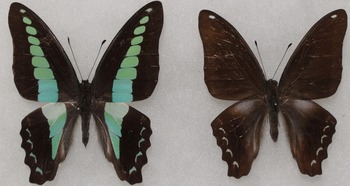
▲アオスジアゲハ表面 左:正常型 右:黒化異常型(いずれもベトナム産)[進化生物学研究所所蔵] ▲Graphium sarpedon (Vietnam)
Left; Normal form Right; Abberant form(preserved in RIEB)
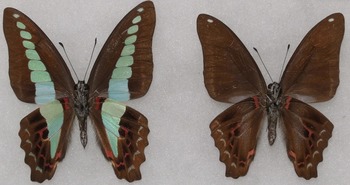
▲ 同裏面 / Ditto, underside
本物の「クロタイマイ」
図示したのは古くからアオスジアゲハの異常型として知られ、「スルスミ型」とも名づけられている個体である。いくつか図鑑類などに図示されている他の個体を参照しても、必ず前翅端の最上部の紋は残っていて、この斑紋は何か重要な意味でも持っているのかと訝ってしまう。
アオスジアゲハは古くは「クロタイマイ」とも呼ばれていたようであるが、この黒化異常型こそその名に相応しいと思ってしまう。
An abberant form of Common Bluebottle (Graphium sarpedon)
Common bluebottle (Graphium sarpedon) is known to have an abberant form which lacks almost all its bluish spots on its wings. This blackish form is very rare but found in many places from old days. Checking the wing patterns of this form carefully, one can find out the one bluish spot on its each forewing's apex usually remains although all the other bluish spots are missing. The reason is not certain but it is possible that this spot may have some special meaning.
にほんブログ村
スミナガシとその近縁種(続) / Genus Dichorragia and its allies (Part 2) [世界の蝶 / Butterflies World]
スミナガシとその近縁種(続)
The Constable (Genus Dichorragia) and its allies (Part 2)

▲スミナガシ(インドネシア・スラウェシ島産)[進化生物学研究所・所蔵]
Dichorragia nesimachus pelurius(C. Sulawesi, Indoneia) [preserved in RIEB, Tokyo]
前記事に引き続きスミナガシの近縁種をいくつか紹介したい。スミナガシそのものも分布が広いためか、特に東南アジア島嶼部では、多様な亜種に分化している。図示したのはインドネシア・スラウェシ島の個体だが、日本のものに比べて遥かに大型で、前翅頂の尖り方など、随分雰囲気が違うのがお分かりいただけるかと思う。
Continued to the previous post, the Constable (Genus Dichorragia) and its allies are introduced. First of all, Dichorragia nesimachus has many sub-species especially in southeastern Asian Islands. One of the examples is shown above. This is the subspecies endemic to Sulawesi, Indonesia. It is much larger in size and the pointed apex in forewings is quite different from Japanese subspecies.
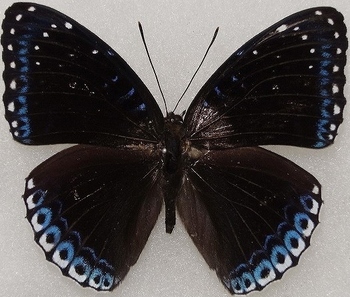
▲シロヘリスミナガシ(中国・雲南省産)[進化生物学研究所・所蔵]
Stibochiona nicea (Yunnan, China) [preserved in RIEB, Tokyo]
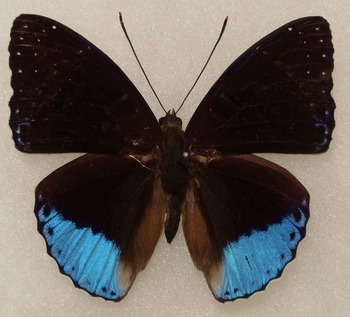
▲ヒメスミナガシ(インドネシア・スマトラ島産)[進化生物学研究所・所蔵]
Stibochiona coresia (Sumatra, Indonesia) [preserved in RIEB, Tokyo]
上記の2種はスミナガシの近縁属Stibochionaで、スミナガシに比べて小型であることからヒメスミナガシと呼ばれることがある。大陸部から島嶼部にかけて3種類が知られる。このうち大陸部に分布が広いシロヘリスミナガシと、スマトラ島やジャワ島など島嶼部に分布するヒメスミナガシを図示する。いずれも何となくスミナガシに近縁なイメージが感じられる。
The above two species belong to Genus Stibochiona. This small Genus contains three species from India to southeastern Asian islands. Among them, Stibochiona nicea is confined to continental Asia from India to China including Indochina and Malaysia. Another species, Stibochiona coresia is known from Sumatra and Java in Indonesia. Both species seem to be allied species of Dichorragia nesimachus from thier wing markings.

▲ジャノメスミナガシ♂表面(インドネシア・スマトラ島産)[進化生物学研究所・所蔵]
Amnosia decora (Sumatra, Indonesia) [preserved in RIEB, Tokyo]
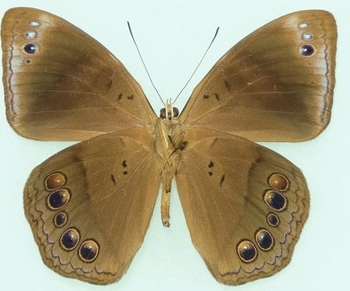
▲同裏面
Ditto, underside
一方、スミナガシの仲間とは一見すると思えない種もいる。上掲のジャノメスミナガシは、表面の斑紋はスミナガシというよりはワモンチョウの一種のようであるし、裏面にいたっては後翅に眼状紋が並ぶ始末。ジャノメチョウ亜科と間違われてしまうような風貌である。じつは本種も幼生期を比較すると明らかにスミナガシに近縁なのだ。一属一種の特異な種で、ジャワ島、スマトラ島などに分布が知られる。
On the other hand, there is a very interesting species in Malaysia and Indonesia. Amnosia decora seems to belong to Amathusiinae or Satyrinae at a glance. But this species is definitely the allied species of Dichorragia nesimachus, considering its early stages. Amnosia is monotypic genus, this species is known from Sumatra or Java in Indonesia.

にほんブログ村
The Constable (Genus Dichorragia) and its allies (Part 2)

▲スミナガシ(インドネシア・スラウェシ島産)[進化生物学研究所・所蔵]
Dichorragia nesimachus pelurius(C. Sulawesi, Indoneia) [preserved in RIEB, Tokyo]
前記事に引き続きスミナガシの近縁種をいくつか紹介したい。スミナガシそのものも分布が広いためか、特に東南アジア島嶼部では、多様な亜種に分化している。図示したのはインドネシア・スラウェシ島の個体だが、日本のものに比べて遥かに大型で、前翅頂の尖り方など、随分雰囲気が違うのがお分かりいただけるかと思う。
Continued to the previous post, the Constable (Genus Dichorragia) and its allies are introduced. First of all, Dichorragia nesimachus has many sub-species especially in southeastern Asian Islands. One of the examples is shown above. This is the subspecies endemic to Sulawesi, Indonesia. It is much larger in size and the pointed apex in forewings is quite different from Japanese subspecies.

▲シロヘリスミナガシ(中国・雲南省産)[進化生物学研究所・所蔵]
Stibochiona nicea (Yunnan, China) [preserved in RIEB, Tokyo]

▲ヒメスミナガシ(インドネシア・スマトラ島産)[進化生物学研究所・所蔵]
Stibochiona coresia (Sumatra, Indonesia) [preserved in RIEB, Tokyo]
上記の2種はスミナガシの近縁属Stibochionaで、スミナガシに比べて小型であることからヒメスミナガシと呼ばれることがある。大陸部から島嶼部にかけて3種類が知られる。このうち大陸部に分布が広いシロヘリスミナガシと、スマトラ島やジャワ島など島嶼部に分布するヒメスミナガシを図示する。いずれも何となくスミナガシに近縁なイメージが感じられる。
The above two species belong to Genus Stibochiona. This small Genus contains three species from India to southeastern Asian islands. Among them, Stibochiona nicea is confined to continental Asia from India to China including Indochina and Malaysia. Another species, Stibochiona coresia is known from Sumatra and Java in Indonesia. Both species seem to be allied species of Dichorragia nesimachus from thier wing markings.

▲ジャノメスミナガシ♂表面(インドネシア・スマトラ島産)[進化生物学研究所・所蔵]
Amnosia decora (Sumatra, Indonesia) [preserved in RIEB, Tokyo]

▲同裏面
Ditto, underside
一方、スミナガシの仲間とは一見すると思えない種もいる。上掲のジャノメスミナガシは、表面の斑紋はスミナガシというよりはワモンチョウの一種のようであるし、裏面にいたっては後翅に眼状紋が並ぶ始末。ジャノメチョウ亜科と間違われてしまうような風貌である。じつは本種も幼生期を比較すると明らかにスミナガシに近縁なのだ。一属一種の特異な種で、ジャワ島、スマトラ島などに分布が知られる。
On the other hand, there is a very interesting species in Malaysia and Indonesia. Amnosia decora seems to belong to Amathusiinae or Satyrinae at a glance. But this species is definitely the allied species of Dichorragia nesimachus, considering its early stages. Amnosia is monotypic genus, this species is known from Sumatra or Java in Indonesia.
にほんブログ村
【動画】ヒカゲタテハ / Movie File: Grey Commodore (Bhagadatta austenia) [世界の蝶 / Butterflies World]
【動画】ヒカゲタテハ
ヒカゲタテハは中国・ヒマラヤ系で一属一種の特異なタテハチョウである。中国からインドシナを経てインドにかけて分布が知られ、主に標高500から1000メートルの中山帯の森林で姿が見られる。飛翔は力強い。ミャンマー北部・カチン州では4月から9月にかけてほぼ連続して姿が見られた。成虫は獣糞や腐果に集まるのが観察された。幼生期は中国・広東省の自然保護区で観察され、当会会誌No.19にWang&Morishita(1998)として報告されている。幼虫や蛹の形態比較からも、分類学上の位置はまだまだ議論の余地のあるところである。
【参考文献 / References】
Wang & Morishita, 1998. Note on the immature stages of Bhagadatta austenia in South China (Lepidoptera, Nymphalidae). Butterflies 19: 30-32.
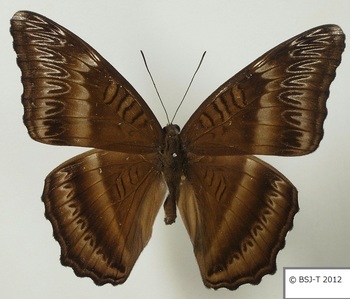
▲ヒカゲタテハ♂ 表面(ミャンマー・カチン州産)
Bhagadatta austenia male Upperside (Kachin, N. MYANMAR)

▲同裏面
Ditto Underside
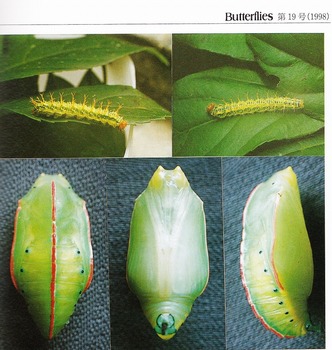
▲幼生期(after Wang & Morishita (1998))
Early stages (after Wang & Morishita (1998))
[Movie File] Grey Commodore (Bhagadatta austenia)
Grey Commodore (Bhagadatta austenia) is a unique Sino-Himalayan nymphalid species known from India, Myanmar, Laos, Vietnam and southern China. Generally it is found in the forest at 500-1,000m. Flight is strong. In Kachin state, northern Myanmar this butterfly was seen from April to September continuously. Adult butterflies were observed to be attracted by animal droppings or rotten fruits. The early stages of this species have been unveiled in southern China. (Wang and Morishita (1998)) The taxonomic status is still uncertain.
(Kachin state, northern MYANMAR May 1999)
にほんブログ村
【動画】シボリアゲハ / Movie File: Bhutan Glory (Bhutanitis lidderdalii) [世界の蝶 / Butterflies World]
【動画】シボリアゲハ
当会のツイッター@bsj_tのフォロワーが1000人を突破してしまったので、約束通り秘蔵の動画を公開したい。恐らくネット上で見られる動画としては現在世界唯一と思われるシボリアゲハの動画である。
シボリアゲハはいわずと知れた世界屈指の奇蝶・美麗種である。ブータン西部からインド東北部、ミャンマー、中国西南部と割と広い分布をしているが、ラオスやヴェトナムでは今のところ未記録、当会名誉会長の故・五十嵐邁氏によって記載されたタイ北部の個体群(ssp. ocellatomaculata)は既に絶滅した。棲息地はアクセスの難しい、辺境の雲霧林であることもあって、生きた本種の姿を見ることは容易でない。なお昨年当会の調査隊がブータンで観察したブータンシボリアゲハ(Bhutanitis ludlowi)は生態・形態の比較によって、本種とはまったく別種と考えられる。(詳細は先に発行された当会会誌No.60を参照されたい)

▲葉上に静止するシボリアゲハ(2002年9月 撮影:TS)
ミャンマーでは北部のカチン州とサガイン管区、西部チン州から記録があるが、絶滅したタイ北部の個体群と隣接する中部シャン州の山岳地からの記録はまだない。元気の良い若者にぜひ探しに行ってもらいたいものである。
今回の動画を撮影したチン州では、シボリアゲハはモンスーン明けの9月から11月まで見られる。どこでもいるわけではなく、良いポイントを当てないと姿を見ることも難しいが、場所によっては車道沿いで見られることもある。
本種の生態で特異なのは、成虫は曇天や霧、小雨の中を好んで飛ぶということである。ほかの蝶をまったく見ないような悪天の中で、原生林の梢をいくつもの個体が活発に飛翔する様子を初めて見たときには、その余りの意外さに驚いたものである。かつてシボリアゲハをインド・ナガヒルで発見した偉大な探検採集家ドヘルティーも、霧の中で無数に舞う本種を見たということである。
シボリアゲハの生息するような雲霧林は、どこでも伐採・開発によって減少しつつある。この素晴らしい蝶が幻となってしまわないことを願いたいものである。
すでに当会のホームページでも公開しているが、2002年に同じくチン州で当会の副運営委員長によって撮影された素晴らしい画像も併せて再掲しておく。
(ミャンマー・チン州にて 2005年10月)
[Movie File] Bhutan Glory (Bhutanitis lidderdalii)
Bhutan Glory (Bhutanitis lidderdalii) is the world famous swallowtail for its bizarre and graceful appearance. It ranges from Bhutan, NW India, Myanmar to S China. The population in Thailand (ssp. ocellatomaculata ) is said to have gone extinct in early 80's. Ludlow's Bhutan Glory (Bhutanitis ludlowi) which is known only from E. Bhutan is a distinct species. Our society had the joint research work on this species in 2011 and unveiled its morphology and biology.
(See Butterflies No.60)
This butterfly appears once in a year after the monsoon. September is the best season to observe this butterfly in most area. This butterfly has a quite odd biology because it is more active in foggy and rainy day. No other butterfly likes to fly in such unpleasant weather. This video was filmed in Chin state, western Myanmar in 2005. I have never seen any video of this butterfly (though some photos are found on the Internet), so I decided to share it. Sorry for the low quality of the video.
(Chin state, W MYANMAR Oct. 2005)
にほんブログ村
【動画】キゴマダラ / Movie File: Eastern Courtier (Sephisa chandra) [世界の蝶 / Butterflies World]
【動画】キゴマダラ
キゴマダラはネパールから中国まで広く分布するが、どこでも数は多くない。特に♀は極めて希少な上に多くのフォームがあり、一部の愛好家に人気が高い。キゴマダラはまだまだ整理がされていないようで、本種に詳しい当会の増井暁夫理事によれば隠蔽種や新亜種の可能性も秘めているという。その一つの例がブータンのものである。図示したミャンマー産の標本と動画を見比べていただければ分かると思うが、前翅表面の亜外縁の斑紋が、ブータンのものはすべてオレンジ色を呈している。増井理事によればこの変異が見られるのはブータンだけだそうで、今後の詳しい検討が待たれるところである。この動画は去年のブータンシボリアゲハ調査隊のメンバーが撮影したもので、撮影場所はブータン西部の首都ティンプーの郊外である。
(ブータン・ティンプーにて 2011年7月)

▲ミャンマー北部・カチン州産の♂表面

▲同裏面
[Movie File] Eastern Courtier (Sephisa chandra)
Eastern Courtier (Sephisa chandra) ranges broadly from Nepal to China, but uncommon throughout its range. Especially females are quite rare and known to have many variations, so quite popular among butterfly enthusiasts. This species has not yet to be studied in detail, Mr. Masui Akio, the trustee of our society and the expert on this butterfly, emphasizes. According to him, there is still much possibility that cryptic species or new subspecies is found from this species. One of these possibilities is the population in Bhutan. Please compare the butterfly filmed in the movie file with the following figures of the specimen from Myanmar. The one in Bhutan, the upperside markings in forewings are all orange. Mr. Masui pointed that this all-orange form is so far found only from Bhutan and further study is needed.
This movie file is filmed by one of the members of the BSJ/Bhutan expedition for searching Ludlow's Bhutan Glory (Bhutanitis ludlowi) in Thimphu, the capital, located in eastern Bhutan.
(Thimphu, BHUTAN, July 2011)

▲Male, upperside (Kachin, N. Myanmar)

▲Ditto, underside
にほんブログ村
毛で隠すか? ゴミで隠すか? / Use own hairs or dusts to hide eggs [世界の蝶 / Butterflies World]
毛で隠すか? ゴミで隠すか? ~「アカシジミの産卵」余話
前回の記事はビデオ自体の面白さもあって、読者にたいへん好評だった。いろいろな方から示唆に富むご意見をいただいたので、あれこれ考える良いきっかけになった。
そんな中、ふと思い出したのが、同じゼフィルスの仲間でもアカシジミのようにゴミを集めるのではなく、自分の腹端の毛で隠す種類もいたということだ。1995年に発行された当会会誌No.10にその記事が掲載されているので参考に再録しておきたい。ネパールやインドから知られるクルミを食べるゼフィルス、クルミシジミ(Chaetoprocta odata)である。この種類は♀の腹部にボールのようなかたちをした毛束を持ち、産卵時には卵塊にこの毛をなすりつけて隠すことで知られている。
毛で隠すか、ゴミで隠すか。シジミチョウのこうした生態の進化の歴史には興味が尽きない。

▲クルミシジミ成虫と雌雄の尾端(加藤・原田(1995)より)
The adult butterfly of Walnut Blue Hairstreak (Chaetoprocta odata) with the magnified abdomens of both sexes (after Kato et Harada (1995))

▲毛で覆われた卵塊(出典同上) / Eggs which are covered by hairs (ibid.)
Which way does the mother butterfly hide her egg --- to use own hairs or to collect dusts? (Continued to the previous post)
Previous post has been popular among readers of this blog because the movie file was quite unique. Many experts gave suggestive comments.
While the author of this blog stopped to think over the ecology of Lycaenidae, he remembered one old article of our journal. The article introduces another Lycaenidae, a kind of Zephyrus Hairstreak, which has a habit of hiding its eggs by its own hairs on the abdomen. The above images are from Butterflies No. 10 (1995). This species, Walnut Blue Hairstreak (Chaetoprocta odata) is known from India and Nepal. As the name explains, its hostplant is the walnut trees (Juglans spp.). Females of this species have a ball-like cluster of hairs on the tip of their abdomen. When they lay eggs, they rub these hairs against their eggs to hide.
Which way does the mother butterfly hide her egg --- to use own hairs or to collect dusts? The evolution of such behavior found in some Lycaenidae is quite interesting.

にほんブログ村
前回の記事はビデオ自体の面白さもあって、読者にたいへん好評だった。いろいろな方から示唆に富むご意見をいただいたので、あれこれ考える良いきっかけになった。
そんな中、ふと思い出したのが、同じゼフィルスの仲間でもアカシジミのようにゴミを集めるのではなく、自分の腹端の毛で隠す種類もいたということだ。1995年に発行された当会会誌No.10にその記事が掲載されているので参考に再録しておきたい。ネパールやインドから知られるクルミを食べるゼフィルス、クルミシジミ(Chaetoprocta odata)である。この種類は♀の腹部にボールのようなかたちをした毛束を持ち、産卵時には卵塊にこの毛をなすりつけて隠すことで知られている。
毛で隠すか、ゴミで隠すか。シジミチョウのこうした生態の進化の歴史には興味が尽きない。

▲クルミシジミ成虫と雌雄の尾端(加藤・原田(1995)より)
The adult butterfly of Walnut Blue Hairstreak (Chaetoprocta odata) with the magnified abdomens of both sexes (after Kato et Harada (1995))

▲毛で覆われた卵塊(出典同上) / Eggs which are covered by hairs (ibid.)
Which way does the mother butterfly hide her egg --- to use own hairs or to collect dusts? (Continued to the previous post)
Previous post has been popular among readers of this blog because the movie file was quite unique. Many experts gave suggestive comments.
While the author of this blog stopped to think over the ecology of Lycaenidae, he remembered one old article of our journal. The article introduces another Lycaenidae, a kind of Zephyrus Hairstreak, which has a habit of hiding its eggs by its own hairs on the abdomen. The above images are from Butterflies No. 10 (1995). This species, Walnut Blue Hairstreak (Chaetoprocta odata) is known from India and Nepal. As the name explains, its hostplant is the walnut trees (Juglans spp.). Females of this species have a ball-like cluster of hairs on the tip of their abdomen. When they lay eggs, they rub these hairs against their eggs to hide.
Which way does the mother butterfly hide her egg --- to use own hairs or to collect dusts? The evolution of such behavior found in some Lycaenidae is quite interesting.
にほんブログ村
絶滅したかマリアナ諸島特産マダラ / Extinct? A Danaid Butterfly endemic to Marianas [世界の蝶 / Butterflies World]

▲マリアナ諸島位置図(ウィキペディアより)
絶滅したか? マリアナ諸島特産マダラ
今や日本人には身近な観光地となり、高校生でも気軽に行ってしまうようになったグァムやサイパン。戦前は日本の委任統治領でもあったこれら北マリアナ諸島の島々には、特産のマダラチョウが記録されているのをご存じだろうか。

▲グァム島東部海岸を望む

▲サイパンマダラ(1946年 ロタ島産、グァム大学所蔵)
サイパンマダラEuploea eleutho である。研究者によってはalgeaの一亜種とする見解もあるようだ。小型で黒地に白い紋の目立つ地味な種類である。グァムやロタ島では1946年以降は新たな記録が無いそうで、サイパン島の北に位置するアラマンガン島とアナタハン島(「アナタハンの女王事件」で有名)で確認された1971年が最後の記録だという。
現在も開発を免れたマリアナ諸島のジャングルに本種が生き残っていることを願いたいものである。
なお、本種をはじめとした絶滅が危惧されるアジア・太平洋地域のマダラチョウについては当会会誌Butterflies No.49に森下和彦氏が下記の論文を寄せているので参照されたい。
森下和彦, 2008. 絶滅したオオムラサキマダラ台湾亜種と生存が危惧されるアジア・太平洋地域のマダラチョウ. Butterflies (Teinopalpus). 49: 82-85

▲Map of Mariana Islands (after Wikipedia)
Extinct? A Danaid Butterfly endemic to Marianas
Guam or Saipan is now quite familiar to Japanese as a tourist resort island. Before WWII, these islands belong to Mariana were Japanese colonies. An endemic Danaid butterfly has been recorded from these islands.

▲View of eastern coast of Guam

▲Mariana Brown Crow (Euploea eleutho), Rota island, collected in 1946, preserved in University of Guam
The species is Mariana Brown Crow (Euploea eleutho). Some researchers treat this species as a subspecies of Euploea algea. Small-sized and rather chic markings with white spots on blackish wings. No record has been obtained since 1946 in Guam and Rota. The last record was 1971 from Alamagan and Anatahan islands which are located in north of Saipan.
We do hope this species is still flying in the jungles of some Mariana islands.
This species is mentioned with other extinct or threatened Danaid butterflies in Asia-Pacific area in the following paper.
Morishita, K., 2008. Euploea phaenareta juvia, an extinct Taiwan race, and some vulnerable danaid butterflies in Asia-Pacific area. Butterflies (Teinopalpus). 49: 82-85
にほんブログ村
タグ:チョウ、蝶



